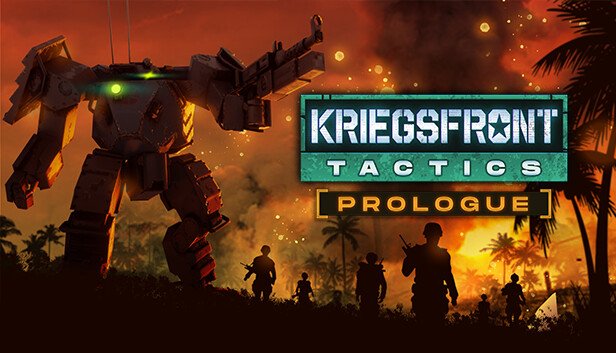Kriegsfront Tactics: Prologue is a single player mecha tactics game from Indonesia’s beloved Toge Productions, who produced and published smash hits like 2020’s Coffee Talk franchise and last year’s A Space for the Unbound.
Kriegsfront Tactics: Prologue was released on June 18, 2024 and serves as a demo and preview of the full title Kriegsfront Tactics. The full release is not yet scheduled but we expect it late-2024 or early-2025 if previous prologue titles from Toge Production are an indication.

In this universe, war is waged using Kriegers (this universe’s version of mechs). The introductory cutscene lays out the status quo in an alternate 1970s, where the United Overseas Company (UOC) is vying for control over the territory of Nusanesia.
Not taking kindly to the annexation attempt, the locals repurposed remnants of the fallen Yamato Empire’s arsenal from World War 2 and are putting up a fierce resistance against the outsiders. The Yamato Empire, UOC and Nusanesians being stand-ins for the Japanese, Dutch and Indonesian factions in the Kriegsfront universe.
We control a band of UOC pilots trudging through the Nairapura territory of Nusanesia as the game introduces its basic combat systems and gameplay elements. You’ll spend roughly 80% of your time in combat while one-fifth of gameplay revolves around mech customisation and overworld navigation.

Gameplay
Fans of the genre will instantly recognise familiar tropes of the tactics genre from games like XCOM and Battletech. Kriegers have customisable modules in interchangeable arms, legs and chests. Movement and battle takes place on a grid-based scenario that costs action points.
In each krieger’s turn, you can take a combination of moving, fighting, overwatch or upkeep (reloading or guarding). You control a squad of up to five kriegers and each unit in Prologue is outfitted as a specific class of soldier.
For example, pointman Aaron sports light gear for reconnaissance and small skirmishes. Daisy is the fragile marksman who can snipe foes from halfway across the map while Ben is a close-combat specialist rocking a knuckle duster and a punchy Fatrock shotgun.

Each member forms an essential puzzle piece of your arsenal, and your ability to beat each mission depends on your ability to utilise their strengths, cover each other’s weaknesses and adapt to enemy formations and threats.
Kriegsfront’s combat is methodical, information is dense and the game rewards calculated gameplay. Rush tactics almost always got me killed and losses can snowball. This genre has a reputation for difficulty and complexity, and Toge isn’t interested in dumbing it down for the sake of accessibility.

At any time, you will need to micromanage resources and factors, including but not limited to; Action points (AP), unit position and facing, ammo count, cover, terrain type, armor, health and fog of war.
To add to the challenge, health and ammo don’t recover after each mission and squad members’ deaths are permanent. You’ll need to conserve your heavy weapon usage and vitality through multiple operations and ration the rare opportunities to repair or resupply your crew on the way to completing the short campaign.
Presentation
Kriegfront’s visual design uses low-resolution, polygonal models reminiscent of PSone-era Front Mission games, which are its most obvious visual inspiration. Combat is from a top-down isometric viewpoint with a generously movable camera.
Missions are located in lush jungles and greenery, decorated with 1970s landmarks like abandoned military outposts and rural settlements. Toge’s signature injection of Indonesian heritage is ever present here as we see candis (14th century temples built by the Hindu-Buddhist civilisation) and Indonesian villages as the backdrop for brutal mechanised warfare.

The Kriegers have a modular and utilitarian design, standing at roughly 5-10 metres tall and sport shades of gray, green and brown to camouflage with the surrounding landscape. I’d argue they camouflage a little too well sometimes as I found myself misclicking the terrain instead of my units and accidentally making a “move” order on more than one occasion. This inconvenience can be worked around by being more deliberate with camera control to ensure you have a clear view of your units and the terrain.
Aside from that, Kriegsfront’s soundtrack is also worth a mention as it borrows heavily from mid-70s period war films like Platoon, Apocalypse Now and Rambo but blended with Indonesian traditional instruments. The gritty rock soundtrack is infused with local sounds like the suling flute, tutuba and gendang to lend Kriegsfront an one-of-a-kind signature sound and is Toge’s commitment to showcasing Indonesian and Southeast Asian qualities to the global audience.
But for me, the single best element of Kriegsfront’s audio design are the SFX from mech movements and combat. The sounds of Kriegers’ hydraulic hissing and joints rumbling as they glide across the battlefield along with explosive gunfire and metallic clashes when the units engage in melees are incredibly satisfying and do a great job of selling the fury and danger of the warzone.

Another drawback, in my opinion, is the dialogue. I commend the voice actors who do a tremendous job of conveying the drama in the heat of battle and also the playful idle banter in the quiet moments between bloodshed.
However, the voice direction is pretty grating, and I found it jarring that characters were voiced with British & American accents despite them being clearly Dutch-inspired. The dialogue is unnecessarily edgy and detracts from the maturity of the underlying themes, and the amount of f-bombs dropped bordered on comical, as if written by a pre-teen who just discovered it.
I won’t touch on narrative elements here as there are pretty gruesome events and carried out in the Prologue, and I’ll be happy if they persist with this level of moral complexity in a war story like this in the full game.
Fun Factor and Recommendation
Conclusively, Kriegsfront Tactics: Prologue succeeds at one thing in particular; building excitement and anticipation for a tough-as-nails tactical experience. I’m eager to see a few things in the full version, namely:
- Being able to play as other factions and see events from different sides of the conflict (Nusanesians, other UOC troops, maybe even Yamato?)
- Greater variety of missions types (escort, point control, survival, extraction)
- Wider customisation of Kriegers and ability to trade krieger parts
- Pilot abilities so you can mix-and-match different characters with new loadouts and create unique teams
- Streamlined controls for menus, like keyboard shortcuts for cycling through tabs/units/parts etc.
- A codex of game rules, lore and technical information.
Director Kris stated that this is a love letter to the mecha tactics genre of old, and based on my impression of Prologue, it’s a successful homage. I’m beyond excited to see what Toge has in store when Kriegsfront Tactics gets its full release in light of their status as the rising star among Asian indie game makers.

This is a definite recommendation to veterans of the genre and gamers who like playing tactical board games too. Prologue doesn’t innovate on the tactics formula, but what it brings is a decent polish. It’s a short campaign that can be wrapped in under 2 hours, and sets up an intriguing conflict to be explored.
For newbies with little to no experience with tactics games, Prologue might be a tougher sell since it assumes a lot of knowledge and experience from the player and unfortunately keeps the barrier of entry for this genre fairly high. Perhaps a more comprehensive tutorial could fix this issue. Then again, it’s only a 2-hour investment and might pique your interest if you’ve enjoyed games rewarding clever planning and risk management.
Kriegsfront Tactics: Prologue is currently free on Steam.
This review was written by Richard Teoh, a member of The CHAM Drinkers talent organisation. Find him yelling about robots, anime, films and food on Twitch or Twitter.













Comments 1